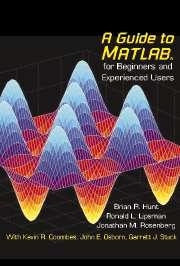9 - Applications
Published online by Cambridge University Press: 05 June 2012
Summary
In this chapter, we present examples showing you how to apply MATLAB to problems in several different disciplines. Each example is presented as a MATLAB M-book. These M-books are illustrations of the kinds of polished, integrated, interactive documents that you can create with MATLAB, as augmented by the Word interface. The M-books are:
Illuminating a Room
Mortgage Payments
Monte Carlo Simulation
Population Dynamics
Linear Economic Models
Linear Programming
The 360° Pendulum
Numerical Solution of the Heat Equation
A Model of Traffic Flow
We have not explained all the MATLAB commands that we use; you can learn about the new commands from the online help. SIMULINK is used in A Model of Traffic Flow and as an optional accessory in Population Dynamics and Numerical Solution of the Heat Equation. Running the M-book on Linear Programming also requires an M-file found (in slightly different forms) in the SIMULINK and Optimization toolboxes.
The M-books require different levels of mathematical background and expertise in other subjects. Illuminating a Room, Mortgage Payments, and Population Dynamics use only high school mathematics. Monte Carlo Simulation uses some probability and statistics; Linear Economic Models and Linear Programming, some linear algebra; The 360° Pendulum, some ordinary differential equations; Numerical Solution of the Heat Equation, some partial differential equations; and A Model of Traffic Flow, differential equations, linear algebra, and familiarity with the function ez for z a complex number.
- Type
- Chapter
- Information
- A Guide to MATLABFor Beginners and Experienced Users, pp. 136 - 213Publisher: Cambridge University PressPrint publication year: 2001



